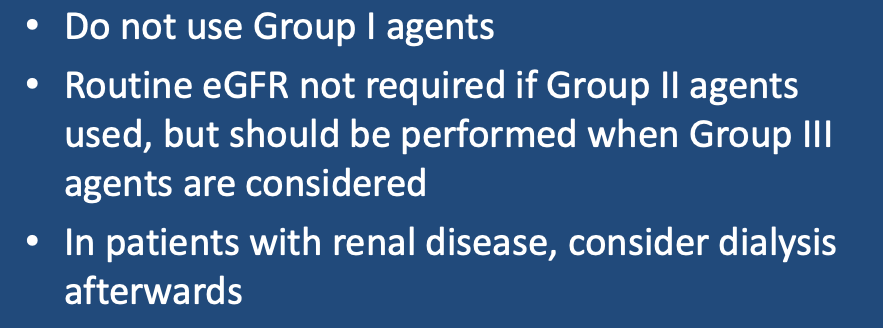Following the "epidemic" of nephrogenic systemic fibrosis (NSF) in the late 2000's, most MRI centers developed policies restricting and/or reducing the use of gadolinium contrast in "at risk" patients. Protocols were created to identify patients with impaired renal function by medical history and measurements of estimated glomerular filtration rate (eGFR). The rationale was that nearly all historically documented cases of NSF had occurred in patients with either acute kidney failure or chronic kidney disease with eGFRs < 30 mL/min/1.73 m². This strategy was successful, as between 2010 and 2020 virtually all NSF cases had been eliminated world-wide.
By the 2020's radiologists began to reconsider whether these approaches were too conservative. Obtaining an eGFR adds extra time and expense, and restricting use of gadolinium contrast in patients with renal insufficiency might adversely impact patient management.
Furthermore, it became widely recognized that overwhelming majority of NSF cases had occurred in patients who had received ACR Group I agents (gadopentetate, gadodiamide, or gadoversetamide). Conversely, only a small handful of cases of NSF had been reported for patients receiving only ACR Group II agents (gadoterate, gadobenate, gadobutrol, gadoteridol). No NSF cases have been documented in patients receiving the newest agents (ACR Group III: gadoxetate and gadopiclenol).
Between 2015 and 2020 multiple papers began to appear in the literature reporting the safety of Group II agents in thousands of patients with renal failure or insufficiency. In 2021 a consensus statement between and American College of Radiology and the National Kidney Foundation explicitly recognized that the risk of NSF was exceedingly low even in patients with kidney disease provided Group II agents in standard dose were administered.
Although each MRI Center must adopt protocols suitable to their needs, I would suggest the following basic tenets be followed based on my perception of current best practices in the United States:
- Use gadolinium contrast only when deemed necessary by the radiologist.
- Do not use Group I agents.
- Routine screening and laboratory testing (eGFR) for renal disease are not required provided standard dose Group II agents are used.
- If a Group III agent is being considered for use, check eGFR. If < 30, consult with clinician.
- For patients on dialysis, contrast administration should ideally be timed before a regularly scheduled dialysis session.
Advanced Discussion (show/hide)»
The Modification of Diet in Renal Disease (MDRD) equation is given by the following equation, computed and reported automatically by most laboratory systems:
eGFR (mL/min/1.73 m²) = 175 x (serum creatinine in mg/dl)−1.154 x (age in yrs)−0.203
This value is multiplied by 0.742 if the patient is female and by 1.212 if African American.
The updated Schwartz equation is given by
eGFR (mL/min/1.73 m²) = 0.413 x (height in cm) ÷ (serum creatinine in mg/dl)
References
ACR Committee on Drugs and Contrast Agents. ACR Manual on Contrast Agents, 2024. American College of Radiology, 2024.
Michaely HJ, Aschauer M, Deutschmann H, et al. Gadobutrol in renally impaired patients. Results of the GRIP study. Invest Radiol 2017; 52:55-60.
Nandwana SB, Moreno CC, Osipow MT, et al. Gadobenate dimeglumine administration and nephrogenic systemic fibrosis: Is there a real risk in patients with impaired renal function? Radiology 2015; 276:741-747.
Weinreb JC, Rodby RA, Yee J, et al. Use of intravenous gadolinium-based contrast media in patients with kidney disease: Consensus statements from the American College of Radiology and the National Kidney Foundation. Radiology 2021; 298:28-35. [DOI LINK]
ACR Committee on Drugs and Contrast Agents. ACR Manual on Contrast Agents, 2024. American College of Radiology, 2024.
Michaely HJ, Aschauer M, Deutschmann H, et al. Gadobutrol in renally impaired patients. Results of the GRIP study. Invest Radiol 2017; 52:55-60.
Nandwana SB, Moreno CC, Osipow MT, et al. Gadobenate dimeglumine administration and nephrogenic systemic fibrosis: Is there a real risk in patients with impaired renal function? Radiology 2015; 276:741-747.
Weinreb JC, Rodby RA, Yee J, et al. Use of intravenous gadolinium-based contrast media in patients with kidney disease: Consensus statements from the American College of Radiology and the National Kidney Foundation. Radiology 2021; 298:28-35. [DOI LINK]
Related Questions
Is gadolinium contrast nephrotoxic? Can it be given safely to patients with mild renal insufficiency?
What is NSF? How does gadolinium cause it?
Is gadolinium contrast nephrotoxic? Can it be given safely to patients with mild renal insufficiency?
What is NSF? How does gadolinium cause it?
